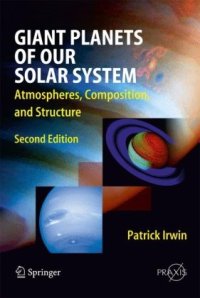
Ebook: Giant planets of our solar system: atmospheres, composition, and structure
Author: Patrick Irwin
- Genre: Physics // Astronomy
- Tags: Физика, Астрономия и астрофизика, Планетология
- Series: Springer-Praxis books in astronomy and planetary sciences
- Year: 2009
- Publisher: Springer
- City: Berlin :, Chichester
- Edition: 2nd ed
- Language: English
- pdf
This book reviews the current state of knowledge of the atmospheres of the giant gaseous planets: Jupiter, Saturn, Uranus, and Neptune. The current theories of their formation are reviewed and their recently observed temperature, composition and cloud structures are contrasted and compared with simple thermodynamic, radiative transfer and dynamical models. The instruments and techniques that have been used to remotely measure their atmospheric properties are also reviewed, and the likely development of outer planet observations over the next two decades is outlined. This second edition has been extensively updated following the Cassini mission results for Jupiter/Saturn and the newest ground-based measurements for Uranus/Neptune as well as on the latest development in the theories on planet formation.
This book reviews the current state of knowledge of the atmospheres of the giant gaseous planets: Jupiter, Saturn, Uranus, and Neptune. The current theories of their formation are reviewed and their recently observed temperature, composition and cloud structures are contrasted and compared with simple thermodynamic, radiative transfer and dynamical models. The instruments and techniques that have been used to remotely measure their atmospheric properties are also reviewed, and the likely development of outer planet observations over the next two decades is outlined. This second edition has been extensively updated following the Cassini mission results for Jupiter/Saturn and the newest ground-based measurements for Uranus/Neptune as well as on the latest development in the theories on planet formation. _________Книга рассматривает текущее состояние знаний об атмосфере газовых планет-гигантов: Юпитера, Сатурна, Урана и Нептуна. Приводятся нынешние теории их образования. Недавно наблюдаемые температуры, состав и облачные структуры сопоставляются и сравниваются с простым термодинамическим, излучательным переходом и динамическими моделями. Второе издание было значительно расширено и дополнено благодаря результатам миссии "Кассини" для Юпитера/Сатурна и новейшим наземным измерениям для Урана/Нептуна, а также последнему разивитию теорий формировании планет.
This book reviews the current state of knowledge of the atmospheres of the giant gaseous planets: Jupiter, Saturn, Uranus, and Neptune. The current theories of their formation are reviewed and their recently observed temperature, composition and cloud structures are contrasted and compared with simple thermodynamic, radiative transfer and dynamical models. The instruments and techniques that have been used to remotely measure their atmospheric properties are also reviewed, and the likely development of outer planet observations over the next two decades is outlined. This second edition has been extensively updated following the Cassini mission results for Jupiter/Saturn and the newest ground-based measurements for Uranus/Neptune as well as on the latest development in the theories on planet formation. _________Книга рассматривает текущее состояние знаний об атмосфере газовых планет-гигантов: Юпитера, Сатурна, Урана и Нептуна. Приводятся нынешние теории их образования. Недавно наблюдаемые температуры, состав и облачные структуры сопоставляются и сравниваются с простым термодинамическим, излучательным переходом и динамическими моделями. Второе издание было значительно расширено и дополнено благодаря результатам миссии "Кассини" для Юпитера/Сатурна и новейшим наземным измерениям для Урана/Нептуна, а также последнему разивитию теорий формировании планет.
Download the book Giant planets of our solar system: atmospheres, composition, and structure for free or read online
Continue reading on any device:

Last viewed books
Related books
{related-news}
Comments (0)